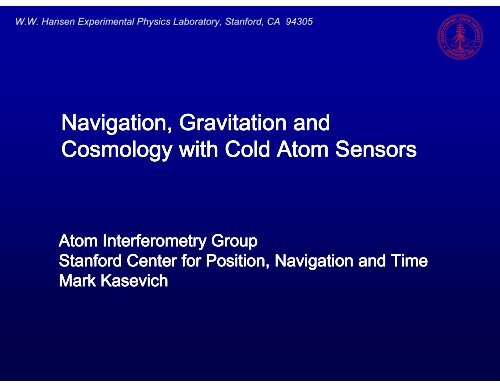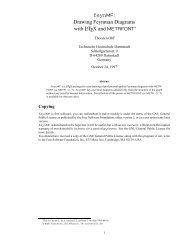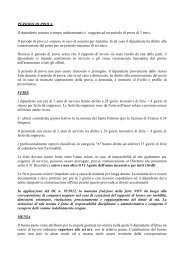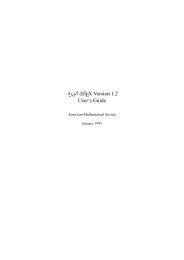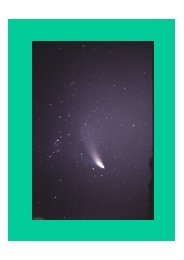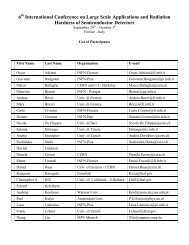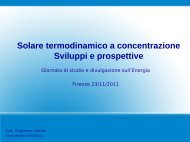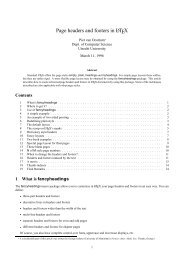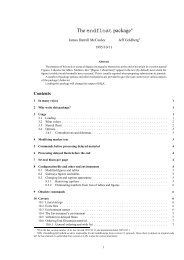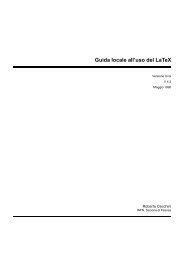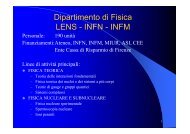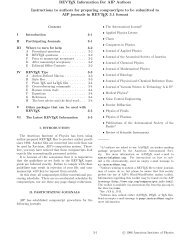Navigation, Gravitation and Cosmology with Cold Atom ... - INFN
Navigation, Gravitation and Cosmology with Cold Atom ... - INFN
Navigation, Gravitation and Cosmology with Cold Atom ... - INFN
Create successful ePaper yourself
Turn your PDF publications into a flip-book with our unique Google optimized e-Paper software.
W.W. Hansen Experimental Physics Laboratory, Stanford, CA 94305<br />
<strong>Navigation</strong>, <strong>Navigation</strong>, <strong>Gravitation</strong> <strong>Gravitation</strong> <strong>and</strong><br />
<strong>and</strong><br />
<strong>Cosmology</strong> <strong>Cosmology</strong> <strong>Cosmology</strong> <strong>with</strong> <strong>with</strong> <strong>Cold</strong> <strong>Cold</strong> <strong>Atom</strong> <strong>Atom</strong> Sensors<br />
Sensors<br />
<strong>Atom</strong> <strong>Atom</strong> Interferometry<br />
Interferometry Group<br />
Group<br />
Stanford Stanford Stanford Center Center for for Position, Position, <strong>Navigation</strong> <strong>Navigation</strong> <strong>and</strong> <strong>and</strong> Time<br />
Time<br />
Mark Mark Kasevich<br />
Kasevich
de Broglie wave sensors<br />
Gravity/Accelerations<br />
As atom climbs gravitational potential,<br />
velocity decreases <strong>and</strong> wavelength<br />
increases<br />
g<br />
(longer de Broglie<br />
wavelength)<br />
Rotations<br />
Sagnac effect for de Broglie waves<br />
A<br />
GGI, 2006<br />
Current ground based experiments <strong>with</strong> atomic Cs:<br />
wavepacket spatial separation ~ 1 cm, phase shift resolution ~ 10 –5 rad
(Light-pulse) atom interferometry<br />
Resonant optical<br />
interaction<br />
|2〉<br />
|1〉<br />
2-level atom<br />
Resonant traveling<br />
wave optical<br />
excitation,<br />
(wavelength λ)<br />
Recoil diagram<br />
GGI, 2006<br />
Momentum conservation between<br />
atom <strong>and</strong> laser light field (recoil<br />
effects) leads to spatial separation<br />
of atomic wavepackets.
Enabling Science: Laser Cooling<br />
Laser cooling techniques are used<br />
to achieve the required velocity<br />
(wavelength) control for the atom<br />
source.<br />
Image source:www.nobel.se/physics<br />
Laser cooling:<br />
Laser light is<br />
used to cool<br />
atomic vapors to<br />
temperatures of<br />
~10 -6 deg K.<br />
GGI, 2006
Laboratory gyroscope<br />
AI gyroscope<br />
ARW 3 μdeg/hr 1/2<br />
Bias stability: < 60 μdeg/hr<br />
Scale factor: < 5 ppm<br />
(submitted for publication)<br />
ARW<br />
GGI, 2006<br />
Bias <strong>and</strong><br />
scale<br />
factor<br />
stability
Laboratory gravity gradiometer<br />
L a s e r B e a m<br />
<strong>Atom</strong>s<br />
<strong>Atom</strong>s<br />
Distinguish gravity induced<br />
accelerations from those due to<br />
platform motion <strong>with</strong> differential<br />
acceleration measurements.<br />
1.4 m<br />
σy(τ)<br />
10 -1<br />
10 -2<br />
10 -3<br />
10 2 10 3 10 4<br />
τ(s)<br />
GGI, 2006<br />
Demonstrated differential<br />
acceleration sensitivity:<br />
4x10 -9 g/Hz 1/2<br />
(2.8x10 -9 g/Hz 1/2 per<br />
accelerometer)
Gravity Gradiometer: Measurement of G<br />
Yale, 2002 (Fixler PhD thesis)<br />
Pb mass translated vertically along<br />
gradient measurement axis.<br />
GGI, 2006<br />
Status: δδδδG/G ~ 3 ppt (submitted for<br />
publication). See also Tino, MAGIA
Light-puse AI accelerometer<br />
characteristics<br />
• Bias stability:
<strong>Navigation</strong> performance<br />
Determine geo-located<br />
platform path.<br />
Necessarily involves geodetic<br />
inputs<br />
Simulated navigation solutions.<br />
5 m/hr system drift demonstrated.
Compact gravity gradiometer/gyroscope/accelerometer<br />
Multi-function sensor measures<br />
gravity gradient, rotation <strong>and</strong><br />
linear acceleration along a single<br />
input axis.<br />
Interior view<br />
Laser system
Control electronics frames<br />
(controls 6 sensor heads)<br />
Laser frames<br />
(scalable architecture<br />
provides light for 2-6<br />
sensor heads)<br />
Sensor electronic/laser subsystems<br />
DSP Master<br />
Sensor<br />
Master<br />
Amplifier<br />
Amplifier
Next generation integrated INS/GPS<br />
s a te llite n a v ig a tio n<br />
s ig n a ls<br />
`<br />
b e a m s te e r in g<br />
a n te n n a<br />
G e n e r a liz e d V e c t o r D e la y L o c k T r a c k in g N a v ig a t io n S y s t e m<br />
p a r a lle l c o r r e la to r<br />
b a n k<br />
`<br />
`<br />
c lo c k<br />
` `<br />
c h ip s c a le a to m ic<br />
c lo c k<br />
C o r d in a t e<br />
t r a n s la t o r<br />
`<br />
g e n e r a liz e d<br />
K a lm a n filte r<br />
`<br />
`<br />
K a lm a n<br />
F ilt e r<br />
In t e g r a t io n o f R F s a t e llit e , in e r t ia l, a n d c lo c k s e n s o r s in t o o n e<br />
q u a s i- o p t im a l N a v ig a t io n , A t t it u d e , T im e e s t im a t o r<br />
Stanford Center for Position, <strong>Navigation</strong> <strong>and</strong> Time.<br />
In collaboration <strong>with</strong> Per Enge, Jim Spilker<br />
IM U<br />
a to m ic in e r tia l<br />
m e a s u r e m e n t<br />
u n its<br />
<strong>Atom</strong>ic physics<br />
contributions<br />
GGI, 2006
Space-based applications<br />
• Platform jitter suppression<br />
– High resolution line-of-sight imaging from space<br />
– Inertial stabilization for next-generation telescopes<br />
• Satellite drag force compensation at the 10 -10 g accuracy level<br />
– GPS satellite drag compensation<br />
– Pioneer-type experiment<br />
• Autonomous vehicle navigation, formation flying<br />
Existing technology:<br />
- ESGN (submarine navigation)<br />
- Draper LN-TGG gyro<br />
- Litton/Northrop HRG<br />
(Hemispherical Resonator)<br />
LN-TGG; 1 nrad 0.1-100 Hz<br />
source: SPIE 4632-15<br />
Fibersense/NG<br />
IFOG
Accelerometers<br />
Earth<br />
Space-based geodesy (also lunar geodesy)<br />
100 m – 100 km<br />
300 km<br />
Accelerometer sensitivity: 10 -13 g/Hz 1/2<br />
− Long free-fall times in orbit<br />
Measurement baseline<br />
− 100 m (Space station)<br />
− 100 km (Satellite constellation)<br />
Sensitivity:<br />
− 10 -4 E/Hz 1/2 (Space Station)<br />
− 10 -7 E/Hz 1/2 (Satellite constellation)<br />
Earthquake prediction; Water table<br />
monitoring<br />
GOCE mission, 4x10 -3 E<br />
http://www.esa.int/export/esaLP/goce.html
Co-falling 85 Rb <strong>and</strong> 87 Rb ensembles<br />
Equivalence Principle<br />
Evaporatively cool to < 1 μK to<br />
enforce tight control over kinematic<br />
degrees of freedom<br />
Statistical sensitivity<br />
δg ~ 10 -15 <strong>with</strong> 1 month data<br />
collection<br />
Systematic uncertainty<br />
δg ~ 10 -16 limited by magnetic field<br />
inhomogeneities <strong>and</strong> gravity<br />
anomalies.<br />
Also, new tests of General Relativity<br />
Precursor to possible space-based<br />
system.<br />
10 m<br />
10 m atom drop tower.<br />
~10 cm wavepacket<br />
separation (!)
Use st<strong>and</strong>ard methods to<br />
analyze spurious phase shifts<br />
from uncontrolled:<br />
• Rotations<br />
• Gravity<br />
anomalies/gradients<br />
• Magnetic fields<br />
• Proof-mass overlap<br />
• Misalignments<br />
• Finite pulse effects<br />
Known systematic effects<br />
appear controllable at the δg ~<br />
10 -16 level.<br />
[δG/G ~ 10 -5 is feasible (limited<br />
by test mass)]<br />
Error Model
Equivalence Principle Installation<br />
<strong>Atom</strong>ic source<br />
10 m atom drop tower.
Light-pulse interferometer<br />
phase shifts for<br />
Schwarzchild metric:<br />
• Geodesic propagation<br />
for atoms <strong>and</strong> light.<br />
• Path integral<br />
formulation to obtain<br />
quantum phases.<br />
• <strong>Atom</strong>-field interaction<br />
at intersection of laser<br />
<strong>and</strong> atom geodesics.<br />
<strong>Gravitation</strong><br />
Objective:<br />
Ground-based precision<br />
tests of post-Newtonian<br />
gravity.<br />
Post-Newtonian trajectories for classical<br />
particle:<br />
From Weinberg, Eq. 9.2.1<br />
Prior work, de Broglie interferometry: Post-Newtonian effects of gravity on quantum<br />
interferometry, Shigeru Wajima, Masumi Kasai, Toshifumi Futamase, Phys. Rev. D, 55,<br />
1997; Bordé, et al.
Ground-based Post-Newtonian Interferometry<br />
Calculated phase shifts for ground<br />
based, 10 m, apparatus.<br />
• Analysis indicates that several<br />
post-Newtonian terms are<br />
comfortably <strong>with</strong>in apparatus<br />
reach.<br />
• In-line, accelerometer,<br />
configuration (milliarcsec link to<br />
external frame NOT req’d).<br />
• New constraints of PPN<br />
parameters.<br />
• Identification of most-promising<br />
space-based tests.<br />
Collaborators: Savas Dimopoulos,<br />
Peter Graham, Jason Hogan.
<strong>Cosmology</strong><br />
Are there (local) observable phase shifts of cosmological<br />
origin?<br />
Analysis has been limited to simple metrics:<br />
– FRW: ds 2 = dt 2 – a(t) 2 (dx 2 +dy 2 +dz 2 )<br />
– McVittie: ~Schwarzchild + FRW<br />
Work in progress …<br />
Future theory: Consider phenomenology of<br />
exotic/speculative theories (after validating<br />
methodology)<br />
Giulini, gr-qc/0602098<br />
Collaborators: Savas Dimopoulos,<br />
Peter Graham, Jason Hogan.<br />
From MTW
Future technology: Quantum Metrology<br />
<strong>Atom</strong> shot-noise limits sensor performance.<br />
Recently evolving ideas in quantum information science have<br />
provided a road-map to exploit exotic quantum states to significantly<br />
enhance sensor performance.<br />
– Sensor noise scales as 1/N where N is the number of particles<br />
– “Heisenberg” limit<br />
– Shot-noise ~ 1/N 1/2 limits existing sensors<br />
Challenges:<br />
– Demonstrate basic methods in laboratory<br />
– Begin to address engineering tasks for realistic sensors<br />
Impact of successful implementation for practical position/time<br />
sensors could be substantial.<br />
Enables crucial trades for sensitivity, size <strong>and</strong> b<strong>and</strong>width.
• Exploit exotic quantum<br />
states to measure phase<br />
shifts at Heisenberg (1/N)<br />
limit<br />
• CQED approach promising<br />
for precision sensors.<br />
Dispersive atom-cavity<br />
shifts enable requisite QND<br />
state preparation.<br />
• Possible 10x to 100x<br />
improvement in sensor<br />
noise.<br />
J Z<br />
J x<br />
J y<br />
Spin squeezed state<br />
enables 1/N sensitivity<br />
Quantum Metrology<br />
Possible QND detection of atom<br />
number (~5 atom resolution).
• Precision navigation<br />
– Pioneer<br />
• Equivalence Principle<br />
• Post-Newtonian gravity<br />
• <strong>Cosmology</strong><br />
Summary<br />
• + quantum metrology in future sensor generations
Thanks<br />
– Todd Gustavson, Research Scientist<br />
– Boris Dubetsky, Research Scientist<br />
– Todd Kawakami, Post-doctoral fellow<br />
– Romain Long, Post-doctoral fellow<br />
– Olaf M<strong>and</strong>el, Post-doctoral fellow<br />
– Peter Hommelhoff, Post-doctoral fellow<br />
– Ari Tuchman, Research scientist<br />
– Catherine Kealhoffer, Graduate student, Physics<br />
– Wei Li, Graduate student, Physics<br />
– Hui-Chun Chen, Graduate student, Applied Physics<br />
– Ruquan Wang, Graduate student, Physics<br />
– Mingchang Liu, Graduate student, Physics<br />
– Ken Takase, Graduate student, Physics<br />
– Grant Biedermann, Graduate student, Physics<br />
– Xinan Wu, Graduate student, Applied physics<br />
– Jongmin Lee, Graduate student, Electrical engineering<br />
– Chetan Mahadeswaraswamy, Graduate student, Mechanical engineering<br />
– David Johnson, Graduate student, Aero/Astro engineering<br />
– Geert Vrijsen, Graduate student, Applied physics<br />
– Jason Hogan, Graduate student, Physics<br />
– Nick Ciczek, Graduate student, Applied Physics<br />
– Mike Minar, Graduate student, Applied Physics<br />
– Sean Roy, Graduate student, Physics<br />
– Larry Novak, Senior assembly technician<br />
– Paul Bayer, Optomechanical engineer


